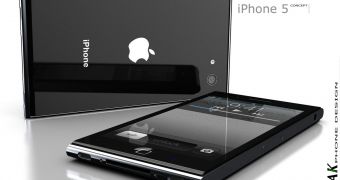If you thought this iPhone 5 concept was cool, check out Antoine Brieux’ mockup. Reminiscent of the iPod nano, it features curved glass and an even more minimalistic form factor than the current (real) iPhone model.
Unlike Michal Bonikowski’s concept, Antoine’s iPhone 5 has a single part casing made out of magnesium alloy, which gives the device a lightweight feel and impressive rigidity, he says.
To us, it looks like an elongated sixth-gen nano, but it also resembles the Nokia N9, and Apple would have a hard time explaining itself to the Finnish cell phone maker, should it go for this design.
Then again, Apple could get away with saying it was their design to begin with.
Back to Antoine’s description of his iPhone 5 incarnation, he weighs in on the phone’s display.
He believes Apple will keep the 326 ppi but will increase the resolution to 1100 x 730, as the Retina screen is now four inches on the diagonal.
The camera is an 8-megapixel one capable of shooting HD video, and has an advanced backside illumination sensor, which allows it to capture beautiful images even in low-lighting conditions.
The LED flash, in Antoine’s vision, does ‘double duty’ on the iPhone 5.
The coolest feature, however, is the new notification LED panel, which displays basic information like new message arrivals, email, battery life, and missed calls. This we’d really like to see come true!
The phone will have Apple’s A5 chip (this much Antoine has nailed for sure) which, according to the designer, provides “more power for full multimedia and game experience” and allows the device to perform complex jobs such as multitasking, 3D games, and even video editing.
Another bullseye Brieux is sure to have hit is the pre-installed iOS 5.
His rather naive attempt at an advertising blurb goes: “The new iPhone is powered by iOS 5 with all new features like the possibility to take a picture with the volume-up button.”
Surely Apple will have a cooler feature to highlight than that.
However, Antoine continues, explaining why he touted that function in the first place: “That’s why on [the] back of the phone, the camera lens has been moved on the other edge to make it easier.”
Check out Antoine’s gallery here.

 14 DAY TRIAL //
14 DAY TRIAL //